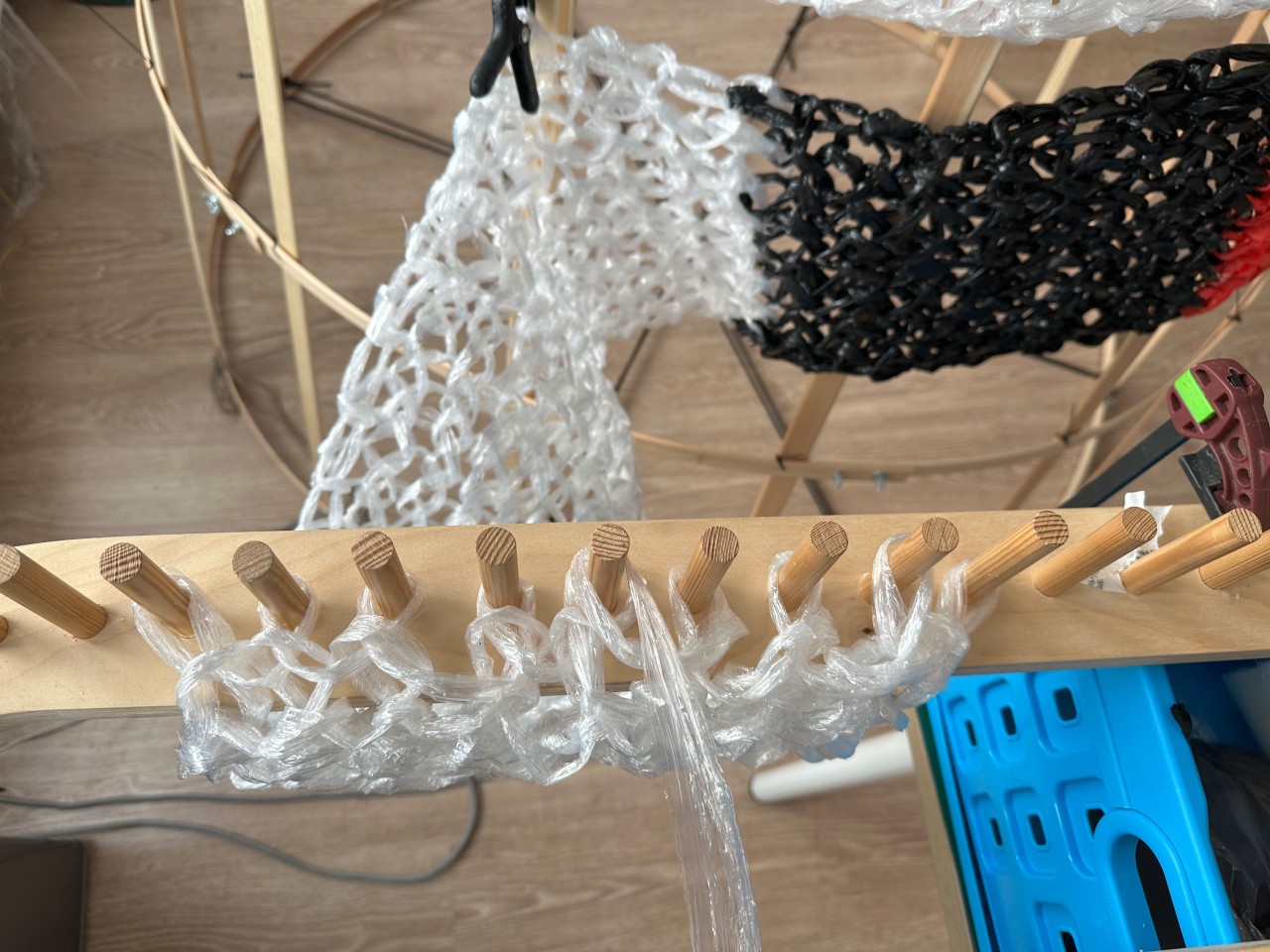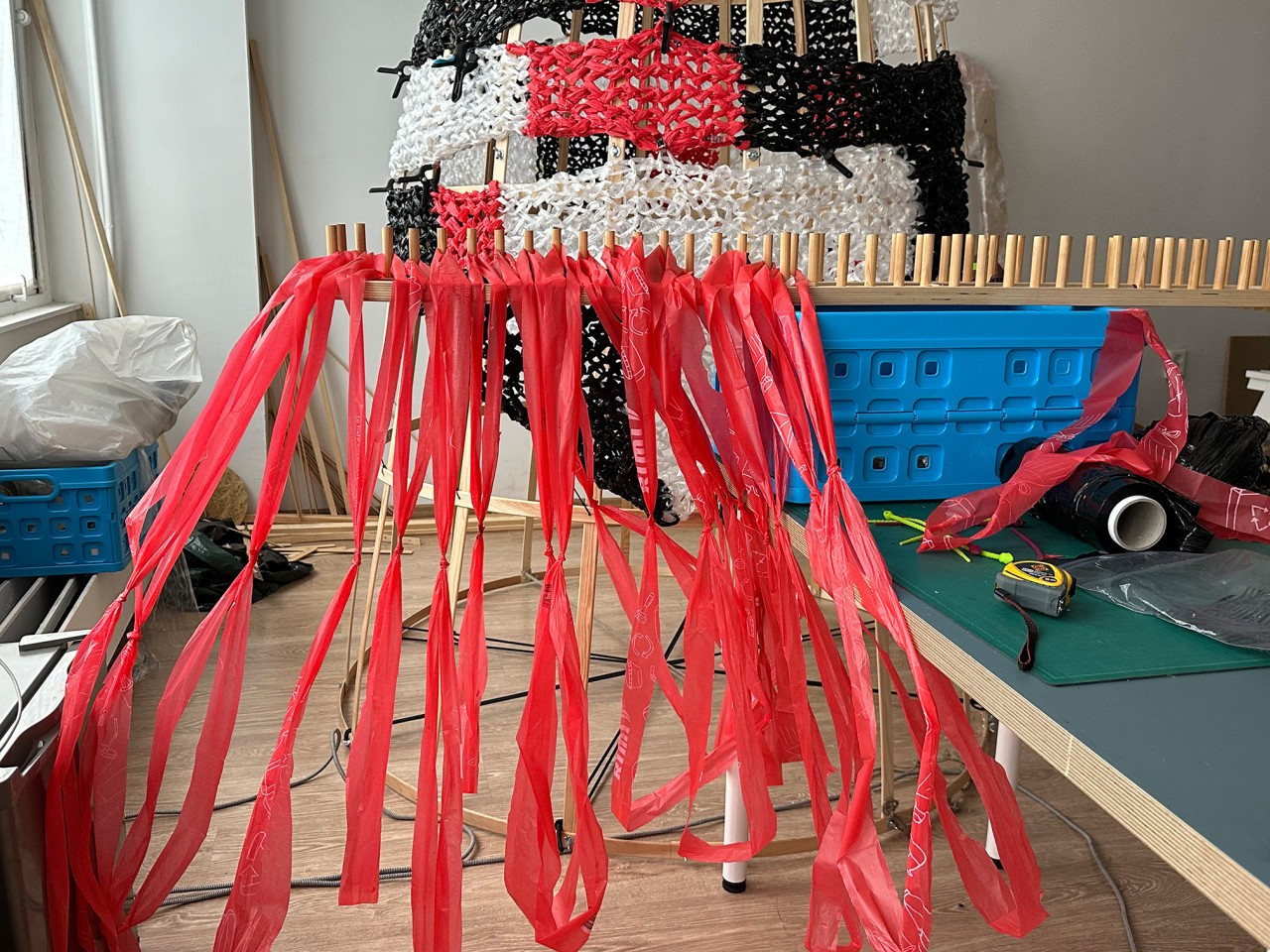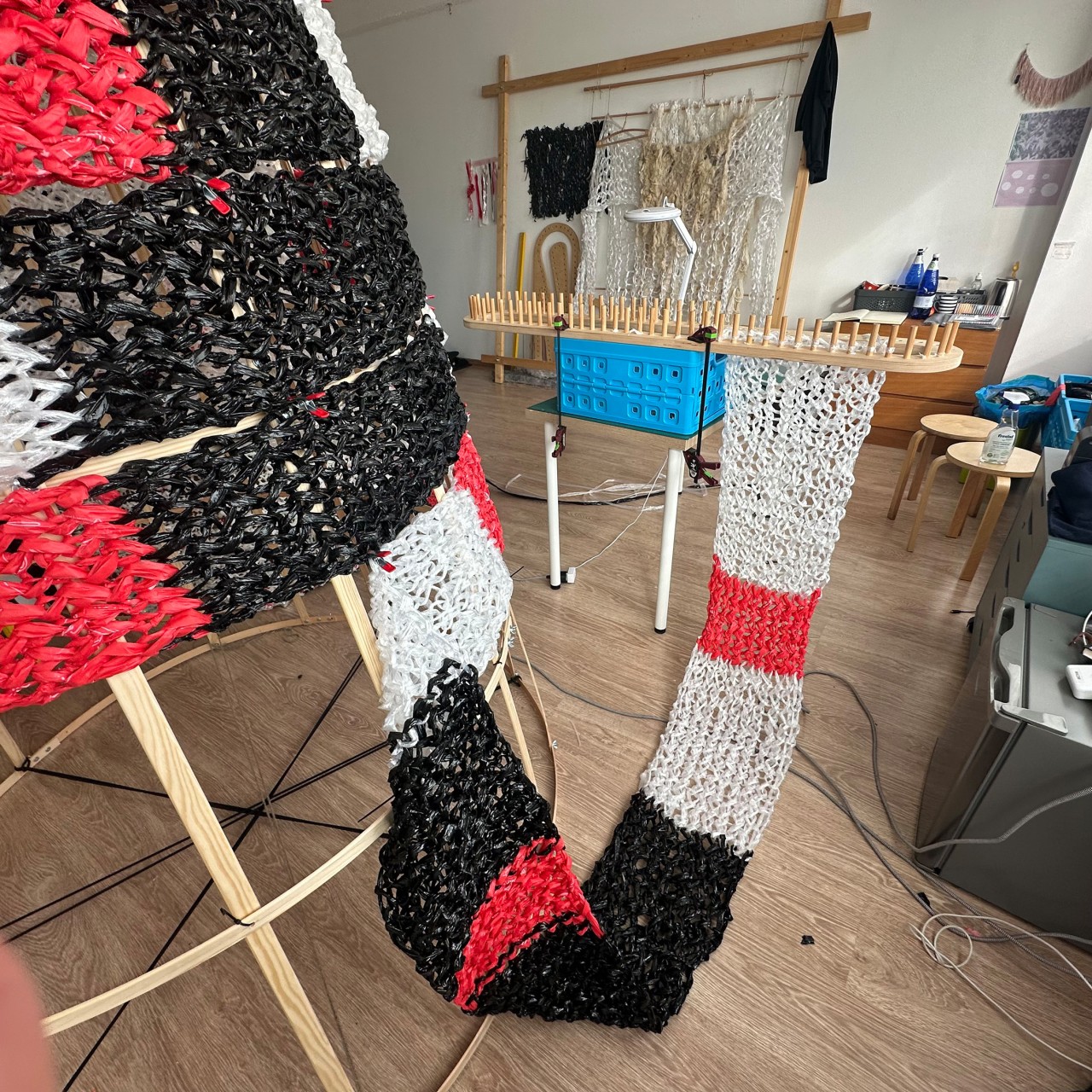Published on 16.12.2024
Gary Markle is a Canadian-born artist and educator living in Tallinn, Estonia and studying in Helsinki, Finland whose practice examines the intersection of cloth, costume and performance. These mediums inform Markle’s research and creation praxis focused on expanded fashion as a lens to contemplate aspects of metamodernism. He provides a site for solo explorations and collaborations with other artists, cultural communities, and environments aimed at understanding the meta-problem of the fashion system as a metaphor for the current state of the planet. Gary Markle is an Associate Professor of Craft at NSCAD University and a Doctor of Arts candidate at Aalto University.
Laura Põld is an artist who lives and works in Tallinn and Vienna. She studies places and territories with a subjective approach as well as observes the relationship between different materials and forces. Her installations emerge through site-specific collaborations involving text, textiles and thread, soil, ceramics and clay, food and plants (or anything else). Since 2010, Põld has worked as a freelance artist, participating in numerous exhibitions and residencies around the world. Currently, Põld works as a visiting lecturer in the department of installation and sculpture at the Estonian Academy of Arts.
This is the tale of two artist-makers connected by a love of hand-skilled production. While the artists are roughly 20 years apart, they are at a similar point in questioning aspects of their artistic careers. The hypothesis is to test thinking-out-loud together as a methodology for discovering hidden insights through a series of recorded studio conversations focusing on skill sharing as a trigger for revealing ideas brought to light by reflecting upon the data. The following is a distilled account of these recorded discussions.1
Why is it significant to seek reflection in or on practice together? Because life in the studio is often isolating, breaking from the monotony of such solo practice is essential to gaining insight and renewing the desire to create.2 As practitioners, we are no strangers to developing skills that require hours to master. Often, there is a drift from the original intention of the creative impulse to the realisation that brings into question the worth of the investment of time and energy. There is an inherent tension and discomfort with slow production, which can feel out of step with the current ethos of neoliberalism in the time of the Multicrisis.
In this light, we decided that by coming together and offering each other a glimpse inside our studio life, we could trigger conversations that, if recorded and reflected upon, might lead to inspiration, resulting in ways to resist and counter the current neoliberal meltdown more consciously.
Situating the distilled conversation
Laura is exploring her current production process to allow for a more economical model, one that would permit her to both produce works that satisfy her artistic goals and to create and care for a team of people who would help her realise her large-scale projects on an as-needed basis. Gary is developing a body of work for his practice-led design research. He is scaling up production and the physical dimensions of his work, forcing him to face the limits of time for crafting by hand, studio space constraints, and increasing material costs.
Early in our conversations, the renowned Estonian artist Anu Raud was evoked as an example of a person we admire. We found her recent embrace of commercial carpet production inspirational because it seems counterintuitive and provocative. Professor Raud is exploring this manufacturing scale to solidify her estimable ‘life work’ and secure capital to support this legacy and the associated Heimtali Museum. Contemplating Raud’s motivation for engaging with commercial production made us question if traditional skills that require a significant investment of time to learn, develop, and execute can be seen as a form of resistance to the madness of our times. Or is devotion to antiquated handicraft skills a foolish wish to ignore ‘reality’? In mixing modes of production, what can be gained, and what is there to lose? We conjectured that Raud has approached the commercial production of carpets with caution and intelligence in making her images accessible to a broader audience; she has done so without compromising her legacy. Instead, tapping into commercial production is a choice that supports and sustains her slow-making practice.

Picking apples
To unfold this paradox, let us ask why people pick apples in autumn and leave a box of them on neighbours’ doorsteps or at the edge of their property. It is a ubiquitous cultural practice, a connection to ideas of traditional values, and, notably, a form of resistance. We tell ourselves this story of ‘apple picking’ to counter and resist the influx of imported produce. While apples are not indigenous to this region, they have been naturalised into the Estonian narrative, and their harvesting by hand holds worth beyond their commercial value. In this act, identity building emerges – a story of self-sufficiency as a national value. While apple picking is primarily a symbolic gesture, it is nonetheless crucial for maintaining the survival of a tale of an independent nature and nationhood.
In this way, skills-based textile and other crafts practices parallel apple picking – both are deeply traditional forms of production ingrained in a value system. They are vital to the building of cultural identity, which has worked to hold a space for resistance not just in Estonia but in much of the West and arguably the full range of ‘worlds’ on this planet. The critical thing to remember about craft-based skills is that they are and always have been more-than-human relationships and collaborations.3
While the dominant stories about cultural and personal identity that place humans at the centre are being challenged and dismantled, we are still forced to consume in order to feed ourselves physically and spiritually. How can we go forward? This conversation is situated within the dilemma of neoliberalism, which we are very much part of – the old binary tale of you and me, self and other, right and wrong no longer works. We want to position ourselves, the reader included, as having agency in rewriting capitalist narratives of despair from the makers’ perspective as a form of resistance from the inside.
Part one: Tufting
Conversation 1 took place at Laura’s studio at ARS on the evening of 15 August 2024.
Keywords: Anu Raud, picking apples, figuring it out as we go along, scales of production, insourcing vs. outsourcing labour, fair wage, fundraising
For the first skill-sharing session, Laura introduced Gary to carpet tufting with yarn. The initial task was for Laura to stretch and staple a cotton base material, called monk’s cloth, onto a massive upright rectangular wooden frame. Then, together, they drew the under sketch for the carpet design with marker pens taped to long sticks. Sharing a similar skill level in drawing, they quickly moved from Laura’s sketchbook to the large canvas scale. The tufting was not as easy as Gary expected, and he could see how labour-intensive this semi-automated process was. How much time and energy must have been invested so that Laura could make it flow seamlessly? The tufting tool was not difficult to operate; the challenging part was the angle of the tool’s insertion into the monk’s cloth and the tension of the yarn as it was fed into the base fabric to get consistent loops while maintaining the visual integrity of the design. Gary experienced it as a four-dimensional process, a strange balance between looseness of motion and firmness of control. He was left with a renewed appreciation for the choreography of making. He was made aware of his bias that tufting was a hobby craft.

Part Two: Peg-Knitting
Conversation 2 occurred in Gary’s studio in the Standard building on the evening of 19 September 2024.
Keywords: skill sharing, discovering meaning through making, scaling up production, creating a body of work

The second evening started with small talk, drifting to conversation threads left dangling from the last session concerning scaling up production for specific projects, for example, Laura’s inclusion in the Helsinki Biennale 2025. New themes in discussion emerged once the skill-sharing started. Beginning with talking about the impetus to create in the first place and how building a body of work is a lifetime achievement that cannot be taken away, Anu Raud’s legacy comes to mind again. Our discussion settled on how we build knowledge through our hands. Tacit ways of knowing (read here as hand-skills) are not fully appreciated as a form of theory – even by those possessing them.4
Laura expressed how sizable the mental effort was to absorb all the new information, from sorting the plastic bags used to make the ribbon-like ‘yarn’ to the threading of the pegs to start knitting. Gary was surprised because his process had evolved incrementally and in solitude. Laura observed that the aesthetic outcome of the peg-knitting process matched, in her opinion, the kind of look and feel she saw several artists adopt at the recent Venice Biennale.
Outcomes
Through listening to the recordings and subsequent deep reflection on the data gathered (while doing studio work), we uncovered three new research questions: 1) How can consciously taking control of personal narratives in practice benefit creative production? 2) How does thinking aloud together as a methodology benefit practice? 3) How do skills-sharing exercises work as a process for creating space for thinking-out-loud together?
This process confirmed the value of knowing by hand and the value of slowness in making, which, if contemplated, is a form of resistance to the fragmentation inherent in current times.
We discovered that we have knowledge that is revealed only when shared. Telling our stories to each other by hand helped us to understand this.
Narrative-making as part of practice puts a sense of control back in our hands. This labour – carving out the time and energy to think consciously about the story we tell ourselves – could be seen as the last thing on a long list of duties. However, we discovered that the time spent reflecting on and sharing our findings was well spent. It allowed us to take back aspects of our creative lives. If we can sustain the practice of (re)creating the stories we tell ourselves, we can hone an excellent tool for reaching beyond mere survival to realising a thriving life.
Thinking-out-loud helped us confront perceived limits and see agency within our processes and practices.
It was helpful to recognise the tension between slow-working methods and the need for accelerated production.
Each exchange outside the bubble of the studio; for example, with curators, galleries, and assistants, represents a necessary friction, pushing us to rethink the value of what we do and question the worth of our efforts when the world around us seems to be moving faster than our hands.
Conclusions
In sharing the fruits of this labour harvested in our metaphorical orchard we have picked some apples to share, in this action we are performing reification; that is to say, the making into a thing of something which is otherwise intangible. In doing so we are able to name it, to give it voice and shape. We learned that thinking out loud is directly connected to making out loud.
In a video call on the evening of Friday, 25 October 2024, to discuss the initial draft of this article, Laura reported that she had already seen results from our experiment. She left a project that did not support her artistic goals, citing a clarity of purpose made possible through this exercise; for Gary, the reflective methodology in action confirmed and reinforced the value of his academic work. He is more confident about engaging publics in conversations through communal crafting as the next step in his doctoral research.
References
- Maarit Mäkelä, and Nithikul Nimkulrat, ‘Documentation as a practice-led research tool for reflection on experiential knowledge’, FormAkademisk 11.2 (2018); Hanna-Kaisa Korolainen, The making of inspiration: From Monet to Warhol and beyond (Aalto University, 2022).
- Jyrki Siukonen, Hammer and silence: a short introduction to the philosophy of tools. (Helsinki: Academy of Fine Arts University, 2015), lk 50-52.
- Hanna-Kaisa Korolainen, The making of inspiration: From Monet to Warhol and beyond (Aalto University, 2022).
- Eik Hermann, ‘How to make concepts with hands: towards material imagination’, Sisu-Line 5 (2020).